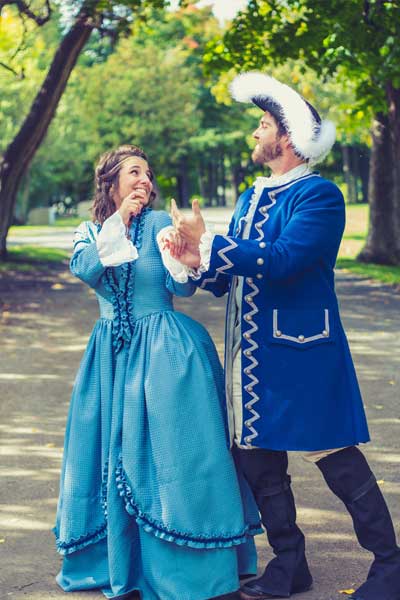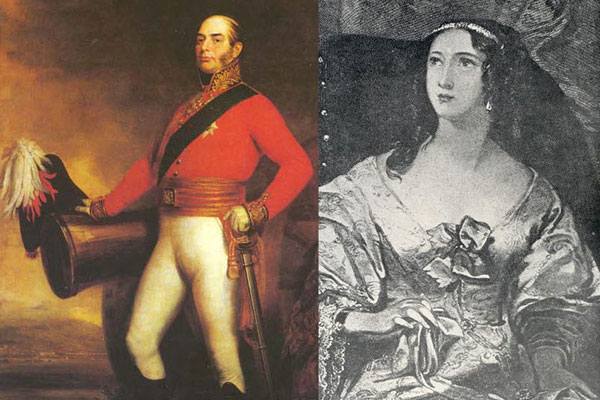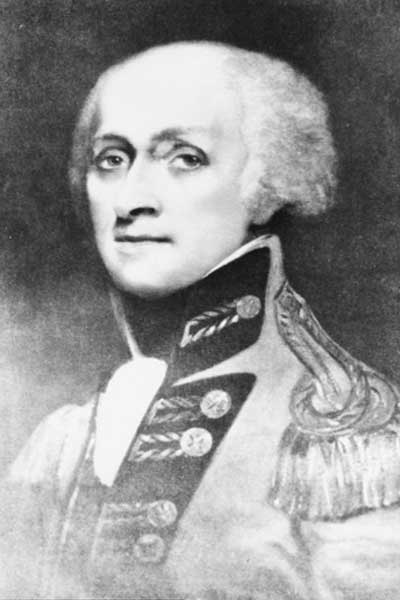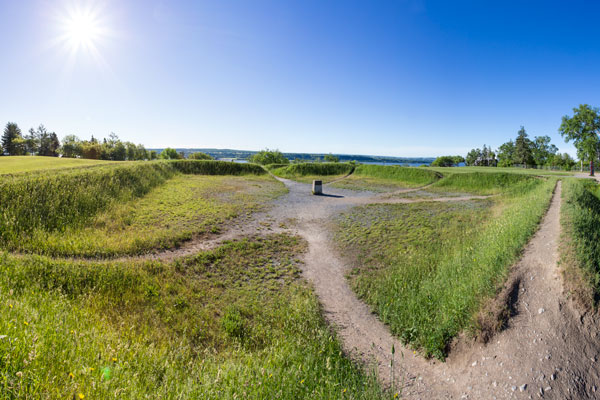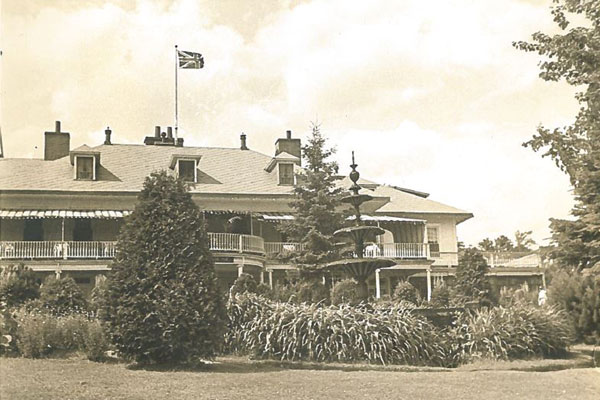History
Its history is rich and astonishing. This location of an impressive tumbling waterfall is closely linked to our collective heritage. It was the site of significant events at the beginning of New France. Over the centuries, it has become one of the most popular tourist destinations of the region.
Mary Jane Patterson
The mysterious heiress to the Patterson empire
We know very little about Mary Jane, the daughter of Peter Patterson. Her date of birth remains unknown, just like her mother’s. On the other hand, we do know that in 1843 she married George Benson Hall, a lumber merchant from Amherstburg in Upper Canada (Ontario). And it was the mysterious Mary Jane who made many changes to the estate.
For example, Mary Jane is responsible for having set up the fountain that sits proudly in front of the Manoir. George and Mary Jane, who had 10 children, completed an expansion of the Manoir to house the entire family and all the servants. The rows of trees located on the land behind the Manoir also owe their existence to Mary Jane.
When her father died, it was she and not her husband who inherited the business and her father's possessions, a rare occurrence in an era marked by rigid patriarchy. She also became Seigneuresse of Beauport, thus succeeding her father. So Mary Jane was, in fact, the owner of the business, and her husband took care of administering it on her behalf! The Seigneuresse passed away in 1880, leaving behind 9 of her 10 children to mourn her departure.
.
Peter Patterson
A pioneer of the forestry industry
After the Duke of Kent left Manoir Montmorency, it remained abandoned and was repeatedly exchanged among various owners, until 1815 when Peter Patterson bought the estate.
Patterson was an English lumber merchant who arrived in Québec City in 1801 with Henry Usborne, an English industrialist, who came to North America to develop the forest industry. Patterson began his career as a businessman working for Usborne, and as of 1809, he took charge of the Québec City branch.
In 1811, Patterson purchased the land beneath Montmorency Falls to set up his hydraulic sawmills. Subsequently, he bought the former residence of Frederick Haldimand and the Duke of Kent, making it his main residence and the heart of his business empire. He never married but did have one child, a daughter named Mary Jane Patterson. Peter Patterson died in 1851, leaving the entire company to Mary Jane.
Living in a castle isn’t always a bowl of cherries
Duke of Kent part II
Oh, the drama! In 1817, our two lovers, Prince Edward and Madame de Saint-Laurent, had to separate. Their love story ended sadly. The prince's sister, Princess Charlotte Augusta, died prematurely without having ensured royal descent. It was therefore the prince’s duty to perform this task.
He could not marry his faithful companion, with whom he had shared his life for 27 years, since she was not noble. He therefore had to put an end to his relationship with Madame de Saint-Laurent in order to marry a German princess, Princess Victoria Mary Louisa, born into a “good family.” He had the pleasure of having a daughter, the little Princess Victoria, who reigned over the British Empire from 1837 to 1901.
Prince Edward was far from suspecting that he would become an enduring part Canadian history. Well, here’s how he did. In 1798, St. John's Island changed its name to Prince Edward Island in his honour. And this was just the beginning! In memory of his father, one of the gates to enter the fortifications of Québec City was named the Duke of Kent. And a Québec City street was also named in the prince’s honour, Rue du Prince-Édouard, in the Saint-Roch neighborhood. In addition, in Nova Scotia, there’s a town called Kentville, to commemorate the duke’s trip to the area in 1794.
Royalty at Montmorency
A love story
There are some beautiful love stories in European folklore. Manoir Montmorency has a love story of its own, straight out of a fairy tale. Once upon a time, there was an English prince by the name of Edward Augustus, also known by his French name, Édouard, or his title, Duke of Kent. His father, King George III, disliked him intensely and tried to keep him as far away as possible from England. He sent the prince off to Germany and Switzerland to get his military education. As soon as the boy’s training was completed, the King promptly dispatched him to head a military expedition in Gibraltar. Shunned by his father and far away from home, the poor Prince Edward felt lonely. He therefore sent envoys to France with a mandate to find him company. They came back with the young and elegant Alphonsine-Thérèse-Bernardine de Montgenêt, also known as Julie de Saint-Laurent. The pair embarked on a genuine love affair.
When the King decided to send his son to the remote, untamed wilderness of Canada, Madame de Saint-Laurent chose to follow her beloved across the Atlantic, to the city of Québec. In summertime, the Duke and his companion liked to get away from the city and hence rented out Haldimand House. They stayed at the Manoir for three consecutive summers, from 1791 to 1794. The young woman ensured that the house was well kept and made clothing and meals.
The couple became friends with members of the Canadian aristocracy, in particular the Salaberry family, who owned the seigneurie of Beauport. Their fondness for each other was such that the Duke and Madame de Saint-Laurent became the godparents of one of the seigneur’s sons, Édouard-Alphonse.
In 1794, the prince was sent to Halifax and to the West Indies before returning to England for good in 1800. The young woman accompanied him during his travels. They lived happily together for 27 years, until…
To be continued…
Frederick Haldimand
Not just a beach in Gaspésie!
The Conquest War, otherwise known as the Seven Years' War (1756-1763), ravaged the colony. However, life resumed its normal course during the following decades. In 1778, Frederick Haldimand was chosen by the British government to succeed Guy Carleton as governor general of the colony. Haldimand quickly fell in love with picturesque Montmorency Falls and in 1780 bought all the land at the top of the waterfall to the west. He commissioned a Palladian style villa, considered to be the first vacation home in Canada!
Haldimand was baptized François-Louis-Frédéric, a name with a Francophone connotation. The fact that a Francophone was appointed governor of a newly minted British colony may seem strange, and it’s interesting to note that Mr. Haldimand was not British but rather French Swiss. His appointment was motivated by his loyalty to the British Crown during the Seven Years' War, and also due to his knowledge of the territory and of the sociocultural realities of the new colony.
By the way, Haldimand beach, considered to be the most beautiful in all of Québec, is a municipal beach located near the town of Gaspé. Moreover, it’s very interesting to note that the Haldimand name is very common in Gaspésie. In fact, a former municipality was called Haldimand, as are a number of roads and trails. Haldimand is therefore synonymous with vacationing in Québec!
The battle of July 31
A hope to save New France
In 1759, Europe and its colonies had already been at war for three years. One of the important issues of this conflict was control over New France, the gateway to the St. Lawrence Valley, providing access to the Great Lakes and the northern interior of the continent.
The Battle of Montmorency, on July 31, 1759, served as a prelude to the Battle of the Plains of Abraham. The English were advancing up the St. Lawrence Valley. On July 9, General James Wolfe set up his camp and his redoubts on the St. Lawrence shore, east of Rivière Montmorency, at the site of what is now the town of Boischatel.
On July 31, Wolfe decided to launch another assault, after a vain attempt to attack the French positions commanded by the Chevalier de Lévis and posted on the St. Lawrence shore, west of Rivière Montmorency, at the site of present-day Québec City. Wolfe’s strategy? To go down the cliff to the east, ford the arm of the river, and climb the cliff to the west. This bold plan proved to be a complete failure. First, Wolfe did not wait for the reinforcements that were supposed to arrive. In addition, a storm struck, making the cliff muddy. Finally, Wolfe retreated because of the rising tide, which would have prevented the English soldiers from returning to their encampment. A failure against the French, leaving the British general with a thirst for revenge…
Manoir Montmorency
In the front row of history!
Many tourists and locals passing along Autoroute Dufferin-Montmorency catch a glimpse of majestic Manoir Montmorency standing proudly on the cliff, but they may well be unaware of its rich history. The first in a long line of owners of the estate was Robert Giffard, first Seigneur de Beauport, who conceded the lot encompassing the present-day Manoir to François Hébert back in 1655. In 1658, François Hébert sold the lot to Charles Courtois, who in turn sold it to Charles Cadieux, Sieur de Courville.
The earliest Palladian-style villa in Canada, the heart of a commercial empire, then a luxury hotel popular with the aristocracy, and today a heritage-based tourist establishment, Manoir Montmorency is a repository of history and of anecdotes unknown to the general public.
Certain owners and tenants would particularly mark the history of Québec, including Frederick Haldimand, the Duke of Kent, and the Patterson family. Each in their own way, they would colour the Manoir’s history.
As well as for famous people, the site of Parc de la Chute-Montmorency was a focal point for significant events such as the Battle of Montmorency on July 31, 1759 and the electrification of Québec City at the end of the 19th century.
Historical thread
1613
Montmorency Falls owes it's name to Samuel de Champlain, who christened it in honour of the Duke of Montmorency, Viceroy of New France and Brittany.
1759
On June 26th, the Quebec siege begins. The English forces, 49 warships, 76 troop transport vessels, 152 landing crafts, some 18 000 seamen and 9000 soldiers, settle their camp on the estuary and shores of the St. Lawrence River. Wolfe establishes his headquarters near Montmorency falls.
1759
On July 31st, the battle of Montmorency is waging. Three English vessels approach the Beauport banks: the Centurion (64 canons), the Three Sisters (14 canons) and the Russel (14 canons). The English troops attempt to scale the cliff. After a day of fighting, 443 deads among the English and some 60 deads on the French side are counted.
1780
Governor Haldimand acquires the land on the West bank of the Montmorency River and builds his country home there (the first Manor). The house was probably the first villa built in Canada and the first major building in the English architectural style.
1791-94
The Duke of Kent stays at the manor every year. The pavilion is named Kent Lodge. Later, the Duke marries a German princess, with who he has a daughter who will become Queen Victoria. It is said that when she was young, Queen Victoria stayed at the Kent Lodge.
1811
Peter Patterson buys a newly built sawmill, which becomes, under the guidance of George Benson Hall, Patterson's son-in-law, the largest sawmill of the era (800,000 feet of wood per day, more than 90 saws, and the employees work 6 days a week, 12 hours a day).
1812
Construction of the first bridge over the Montmorency River.
1815
Patterson buys the Manor and uses it as his main residence.
1823
Patterson and Company continued to expand in the Montmorency area, becoming one of the largest sawmill operations. A second sawmill was built circa 1830.
Construction of a second bridge, which collapses five days after it's completion (the pillars are still standing), causing three fatalities.
1857
Construction of a third bridge over the Montmorency River.
1885
The site of the Montmorency Falls is the stage of an event of worldwide importance: the energy produced by the hydroelectric generating station, inaugurated at the foot of the small fall on October 7th, is carried, for the first time, over a long distance (7 miles). It supplies Quebec City's new tramway network, a 52 volts generator lights up the main streets of Quebec City for two hours every night. Quebec was one of the first municipalities in America to use hydroelectric energy.
1889
Charles Ross Whitehead builds a cotton factory on Hall land.
1892
Last year of operation of the sawmill.
1893
Installation of a hydroelectric power station (three 500Kw generators).
1897
The first electric train runs in Quebec City, using energy from the fall.
1898
Quebec Railways Co. buys the Manor and converts it into a hotel.
1901
Construction of a cable car that makes possible for visitors arriving by train at the foot of the cliff to reach the hotel and its site.
1904
Construction of the St. Mary's Anglican Chapel.
1905
Charles Ross Whitehead's cotton factory becomes the Dominion Textile.
1907-1932
Holt Renfrew builds the first zoo in Quebec, near the Montmorency home (Kent House).
1912
A tramway connects the City of Quebec to the Kent House (Manoir Montmorency).
1926
Construction of the present bridge.
1949
The Manor becomes the property of an American syndicate headed by Henry Mason Day.
1954
The Dominican buy the Manor. Father Georges-Henry Lévesque is the first director of what becomes a retirement home, gathering place retreat for a variety of people.
1975
The Quebec government buys the Manor.
1976
The department of tourism uses the Manor as a hotel for senior citizens. Renovation work is carried out.
1985
The SEPAQ takes over the management of the Manor.
1992
In December, the work for the Parc de la Chute-Montmorency begins.
1993
The Manor is completely destroyed by fire.
1994
The Manor is rebuilt following the original plans.
Beginning of Grands-Feux Loto-Québec, a magnificent fireworks and music competition on the Parc de la Chute-Montmorency site.
2008
Reception of VIPs at Manoir Montmorency during the 12th Francophonie Summit.
Lighting the cove at Parc de la Chute-Montmorency for Québec City’s 400th anniversary.
2011
Final edition of Grands-Feux Loto Québec, which had taken place on the site for 17 years.
2012
In April, the government announced major investments for the enhancement of the site, including a hotel project.
2013
Renovation of the cable cars and the inauguration of three via ferrata circuits, one of which includes a zipline.
2015
Inauguration of the 300-meters length zipline.



